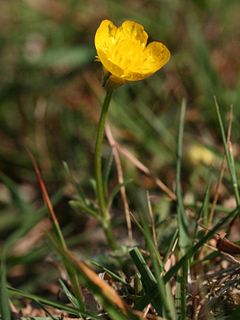
Ranunculus is a large genus of about 600 species of flowering plants in the family Ranunculaceae. Members of the genus are known as buttercups, spearworts and water crowfoots.

Ranunculus repens, the creeping buttercup, is a flowering plant in the buttercup family Ranunculaceae, native to Europe, Asia and northwestern Africa. It is also called creeping crowfoot and sitfast.

Ranunculus bulbosus, commonly known as bulbous buttercup or St. Anthony's turnip, is a perennial flowering plant in the buttercup family Ranunculaceae. It has bright yellow flowers, and deeply divided, three-lobed long-petioled basal leaves.

Ranunculus acris is a species of flowering plant in the family Ranunculaceae, and is one of the more common buttercups across Europe and temperate Eurasia. Common names include meadow buttercup, tall buttercup, common buttercup and giant buttercup.
Ranunculus crassipes is a small flowering plant in the buttercup or crowfoot family Ranunculaceae that is native to the subantarctic region. The specific epithet comes from the Latin and refers to the plant's thicker and more succulent form compared to the closely related R. biternatus.

Ranunculus auricomus, known as goldilocks buttercup or Greenland buttercup, is a perennial species of buttercup native to Eurasia. It is a calcicole typically found in moist woods and at the margins of woods. It is apomictic, and several hundred agamospecies have been recognised.

Ranunculus pinguis is a dark green, fleshy-leaved buttercup with relatively large, short-stalked flowers and narrow stiff yellow petals that grows in tufts. It is an endemic species of New Zealand on the Auckland and Campbell Islands that flowers from December to January and sets seeds between February and April.

Ranunculus biternatus, the Antarctic buttercup, is a plant in the buttercup family Ranunculaceae. It is native to southern South America and some subantarctic islands.

Ranunculus hyperboreus is a species of flowering plant belonging to the family Ranunculaceae.

Ranunculus sulphureus is a species of flowering plant belonging to the family Ranunculaceae.

Ranunculus reptans is a species of flowering plant belonging to the family Ranunculaceae.
Ranunculus propinquus is a species of flowering plant belonging to the family Ranunculaceae.
Ranunculus polyanthemos is a species of flowering plant belonging to the family Ranunculaceae.
Ranunculus fallax is a species of flowering plant belonging to the family Ranunculaceae.

Ranunculus penicillatus is a species of flowering plant belonging to the family Ranunculaceae.
Ranunculus schmalhausenii is a species of flowering plant belonging to the family Ranunculaceae.
Ranunculus kauffmannii is a species of flowering plant belonging to the family Ranunculaceae.
Ranunculus circinatus is a species of flowering plant belonging to the family Ranunculaceae.

Ranunculus gramineus, called the grass-leaved buttercup, is a species of flowering plant in the genus Ranunculus, native to the western Mediterranean; Morocco, Algeria, Tunisia, Portugal, Spain, France, Italy, and Switzerland. It has gained the Royal Horticultural Society's Award of Garden Merit.











